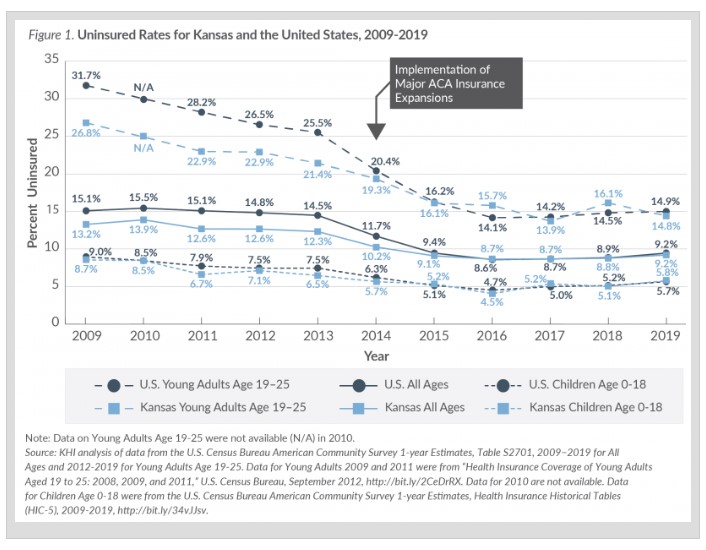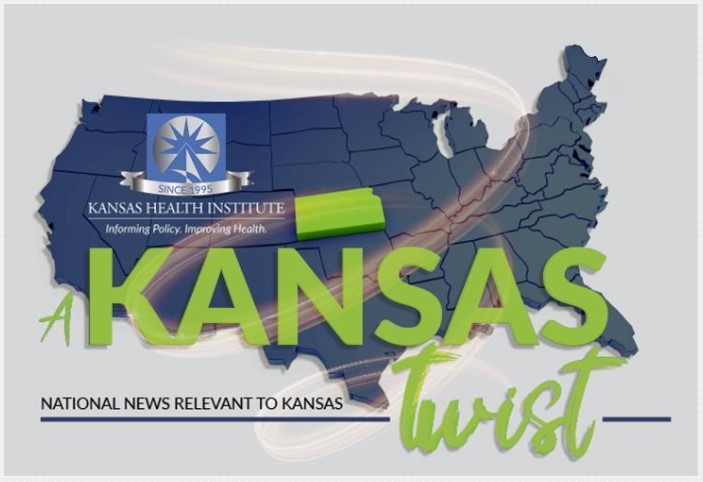As COVID-19 continues to spread across the United States, the disproportionate effect of the pandemic on people of color and lower-income Americans has become clear. While health insurance coverage has lagged for those populations for many years, in some states the gap has been closing. Understanding the health insurance landscape prior to COVID-19 could help policymakers as they consider health insurance coverage options.
Sign up here to receive these summaries and more, and also follow KHI on Facebook, Twitter and LinkedIn. Previous editions of A Kansas Twist can be found on our ARCHIVE PAGE.
On September 17, the U.S. Census Bureau released its latest estimates on health insurance coverage. In 2019, the overall uninsured rates for Kansas and the U.S. were both 9.2 percent (262,000 people in Kansas and 29.7 million in the U.S.), a slight increase from last year (Figure 1), but not statistically significant for Kansas. Relative to other states and the District of Columbia, Kansas ranked 33rd for insurance coverage in 2019, the same as in 2018, but a slip of 11 positions from its ranking in 2009. As we noted last year, even as Kansas has been making progress on insurance coverage, it has been losing ground compared to many other states.

Notably, uninsured rates for some groups have not improved as quickly for Kansas as for the U.S. as a whole. For some racial and ethnic minorities and for persons living in poverty, the gap between Kansas and the U.S. has been widening (Figure 2). For example, Kansas and U.S. had a similar uninsured rate for Hispanics, Any Race, from 2010 to 2014; however, in 2019, the rate for Kansas (23.3 percent) was significantly higher than the rate for the U.S. (18.7 percent). Similarly, in 2019, the uninsured rate for Blacks or African Americans, Any Ethnicity, was significantly higher for Kansas than for the U.S. (13.2 compared to 10.1 percent).
Among individuals whose household income is under 138 percent of the federal poverty level (FPL; $17,236 for an individual and $35,535 for a family of four in 2019), the uninsured rate was 20.2 percent for Kansas compared to 15.9 percent for the U.S. (Figure 3). Since 2014, adults at this income level qualify for Medicaid in states that expanded their program under the Affordable Care Act (ACA). The uninsured rate for Kansas has remained relatively steady since 2014 for those in that income group (22.2 percent in 2014 compared to 20.2 percent in 2019), while the national rate has dropped significantly (20.9 percent in 2014 to 15.9 percent in 2019).
While the uninsured rate declined in Kansas and across the country after the ACA was implemented, the long-standing edge that Kansas had over the U.S. has disappeared. Kansas was one of 18 states that had not expanded its Medicaid program as of January 1, 2019. The uninsured rate dropped much more quickly in states that expanded Medicaid than in states, like Kansas, that did not. Since 2014, nonelderly adults at this income level qualify for Medicaid in states that expanded their program under the Affordable Care Act (ACA).
A Kansas Twist is KHI’s effort to distill important national news and developments into an easily digestible form that explains how it is relevant to Kansas and Kansans.
